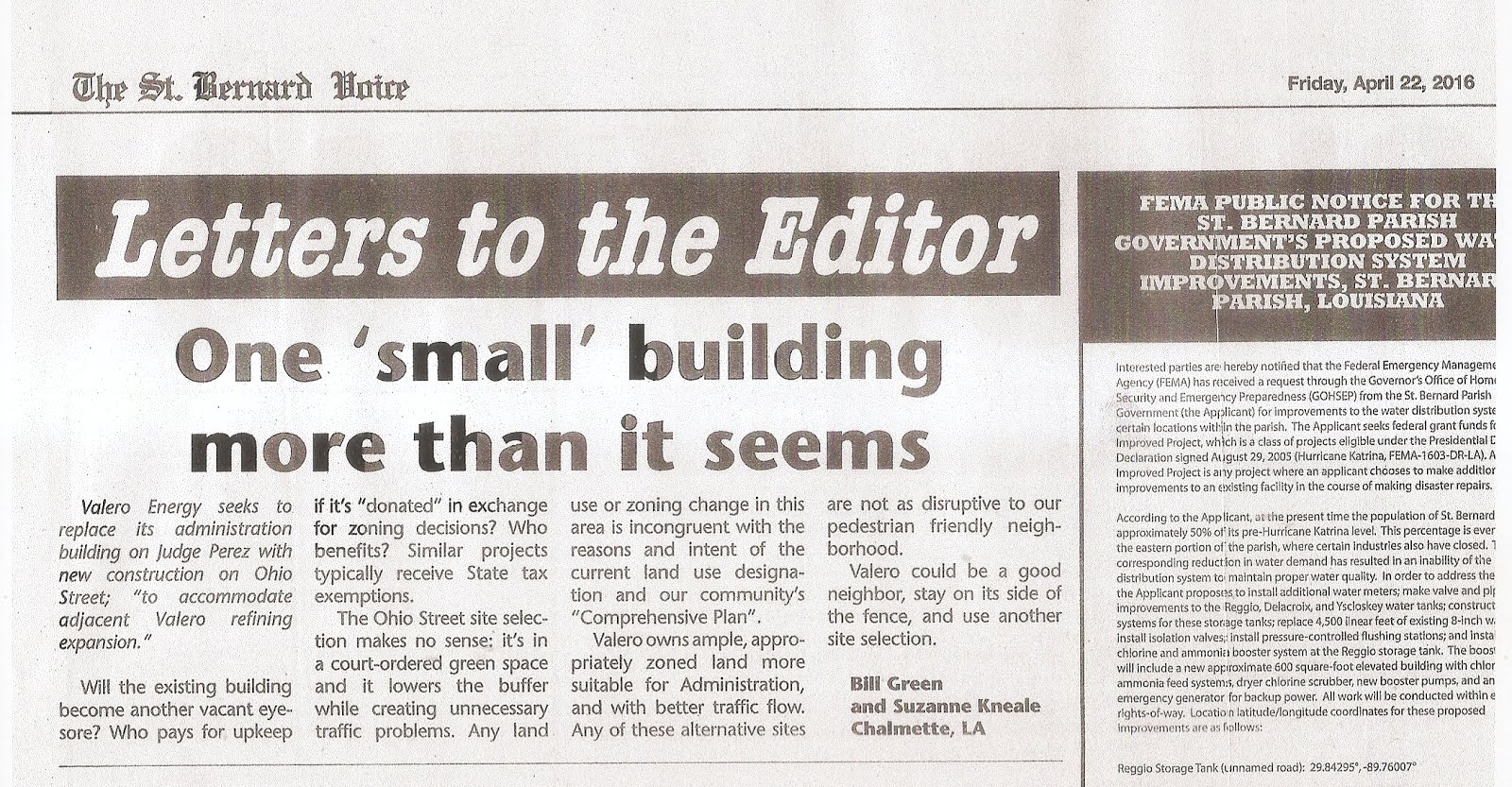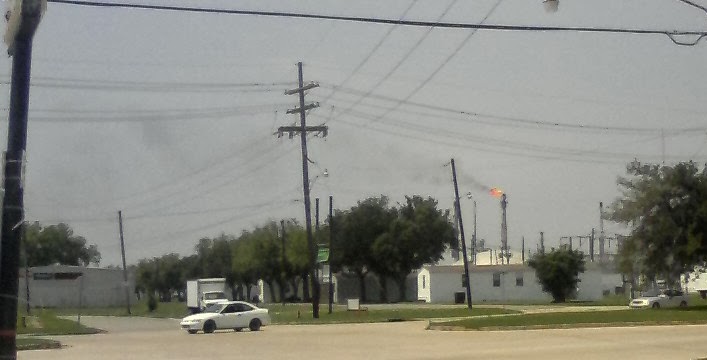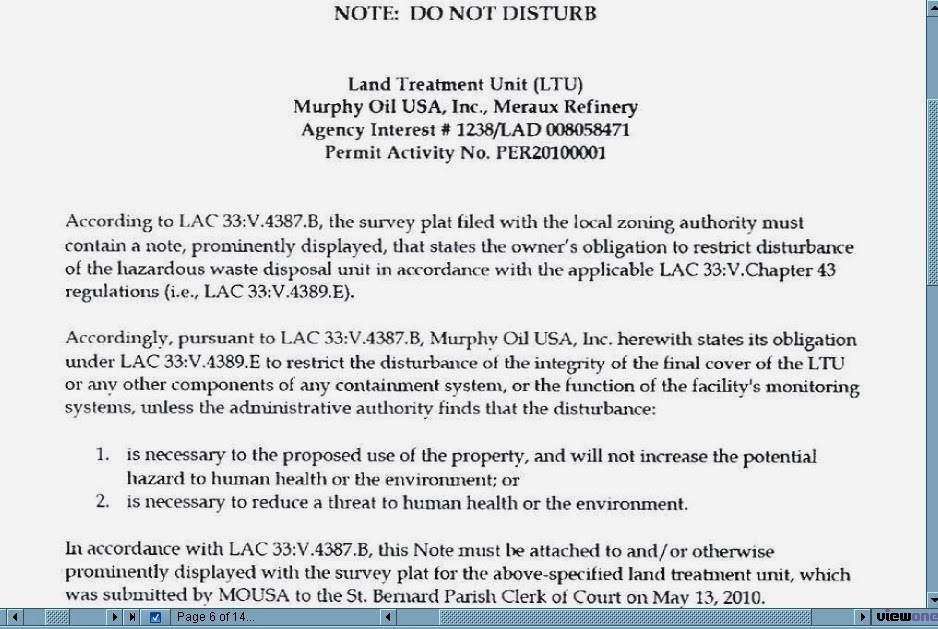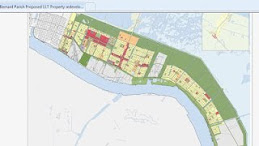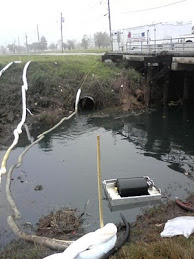Wednesday, June 29, 2016
Monday, June 27, 2016
Public Hearing June 28 2016 4pm
Valero Energy Meraux refinery seeks to construct a new office building in the Ohio Street neighborhood, replacing the 5 story building on East Judge Perez Drive.
Public hearing Tuesday June 28 2016 at 4pm in council chambers.
Labels:
Valero Energy Meraux refinery
Monday, June 20, 2016
the grass is always greener
"The green, green grass of our homes"
Showdown: St. Bernard Parish President - Oct. 29,2007Junior
Rodriquez and Craig Taffaro
"There seems to be a name game being played between St.
Bernard government, Murphy Oil and residents adjacent to the refinery.At times
the residential property bought by Murphy is referred to as "green
space" and at other times it?s referred to as a "buffer
Zone".Green space implies trees, shrubs and flowers while buffer zone
implies a space to restrict something unwanted. Which is it that you will work
toward."Mike
Jr. - Green space only. Council has the power and ability to
pass an ordinance that that?s what it will be is green space. That?s what we need.CT
? Properties that are being bought out in the buyout zone are zoned R1 which
means that there can be nothing but R1 development in that area. Murphy Oil has
continued to tell us and the public they?re not getting into the housing market
at all, so the idea of what that property can be used for is nothing more than
what it is now and since it is not a 100% buyout at this point in time, there
will be no other development there so it will be green space. Buffer zone means
that that?s what that green space will be used
for.```````````````````````````````````````````````````````````````````````````````````````````"I
live on Lena Drive and would like to know about the 4 block area that Murphy
Oil destroyed. What are you going to do about t he sidewalks that were pulled
up and the streets that were destroyed. Don?t beat around the bush. Give us a
straight answer."John
Jr. ? Should be repaired because Murphy Oil caused the problem
and situation. Murphy Oil will repair sidewalks. That?s part of public
demand.CT ? Where there are houses, there will be sidewalks. Where there are
complete blocks that have been purchased and will be used as that green space
in the buffer zone, those sidewalks needed to be removed for the maintenance of
that property. But what we?re talking about is where there are residents still
living between houses there will be sidewalks there. That?s not an issue.
Murphy is giving us some resistance on that, but that?s exactly what we?re
going to do. Where there are residents there will be sidewalks.
Local Housing Redevelopment Committee around the 6 minute mark:
http://sbpg.pegcentral.com/player.php?video=b7858681f49ebe4c286eaebe41418696
http://sbpg.pegcentral.com/player.php?video=b7858681f49ebe4c286eaebe41418696
Transfer of HUD Road Home Properties through the Lot Next
Door Program to Murphy Oil is not intended for commercial; it is for the green
space.
“Keep in mind it is not a commercial interest because it’s
zoned residential and the [adjacent] Murphy lot… is also residential. …… don’t think
it’s the same situation [as a previous case] because the Church wanted to use
it for commercial purposes, Murphy is just obtaining it as part of their green
space.”
Friday, June 17, 2016
what's in your air
The report found that residents who live near the gas sites have a higher amount of the chemicals in their urine than the general population. Scientists focused on how oil and gas fields can pollute the air and how that pollution ends up in humans living nearby. That’s a point Wilma Subra, president of the Subra Company involved in the study, and other leaders in the study have been emphasizing.
“If you have contaminated air, you have no choice but to breathe it,” Subra, who has worked on environmental health research across the country, told ThinkProgress. “That’s why it is so important to help citizens understand the quality of the air they are breathing.”
http://thinkprogress.org/climate/2016/06/16/3788812/chemicals-fracking-health-wyoming/
Study Finds Chemicals in Residents Living Near Gas Wells by Sydney Pereira Jun 16, 2016
What's in your air St. Bernard?
EPA Air Data https://www3.epa.gov/airdata/
Chalmette Vista Monitor https://airquality.deq.louisiana.gov/Data/Site/CHALMETTEVISTA/Date/2016-06-16
Ventura Drive Monitor
http://lena.providenceeng.com/Hourly.aspx [displays some values in ppm instead of ppb. Convert parts per million data to parts per billion by multiplying the value by 1,000. (i.e., 0.024 ppm = 24 ppb).
http://lena.providenceeng.com/Documents.aspx [For benzene, and other air toxin sample results]
Mistrot Drive Monitor
https://airquality.deq.louisiana.gov/Data/Site/MERAUX/Date/2016-06-16
“If you have contaminated air, you have no choice but to breathe it,” Subra, who has worked on environmental health research across the country, told ThinkProgress. “That’s why it is so important to help citizens understand the quality of the air they are breathing.”
http://thinkprogress.org/climate/2016/06/16/3788812/chemicals-fracking-health-wyoming/
Study Finds Chemicals in Residents Living Near Gas Wells by Sydney Pereira Jun 16, 2016
What's in your air St. Bernard?
EPA Air Data https://www3.epa.gov/airdata/
Chalmette Vista Monitor https://airquality.deq.louisiana.gov/Data/Site/CHALMETTEVISTA/Date/2016-06-16
Ventura Drive Monitor
http://lena.providenceeng.com/Hourly.aspx [displays some values in ppm instead of ppb. Convert parts per million data to parts per billion by multiplying the value by 1,000. (i.e., 0.024 ppm = 24 ppb).
http://lena.providenceeng.com/Documents.aspx [For benzene, and other air toxin sample results]
Mistrot Drive Monitor
https://airquality.deq.louisiana.gov/Data/Site/MERAUX/Date/2016-06-16
Thursday, June 16, 2016
new school and cement plant
The community's new elementary school is under construction on State highway 47, just across the highway from the cement batch plant
is that good planning?
is that good planning?
Monday, June 13, 2016
More Louisiana SIP proposals
The Secretary of the LDEQ submitted SIP revisions to address the revised NAAQS for PM 2.5, and except for certain portions pertaining to interstate transport, the EPA proposes to approve the Louisiana SIP for PM2.5
Proposed Action: EPA is proposing to approve in part the infrastructure SIP submissions from Louisiana which address the clean air requirements for PM2.5, Lead, Ozone, Nox and Sulfur Dioxide.
Federal Registry https://www.gpo.gov/fdsys/pkg/FR-2016-06-03/pdf/2016-13032.pdf#page=1
Comments must be received on or before July 5 2016, Submit comments indentified by Docket No EPA R06 OAR 2013 0465 at http://www.regulations.gov or via email to fuerst.sherry@epa.gov
Proposed Action: EPA is proposing to approve in part the infrastructure SIP submissions from Louisiana which address the clean air requirements for PM2.5, Lead, Ozone, Nox and Sulfur Dioxide.
Federal Registry https://www.gpo.gov/fdsys/pkg/FR-2016-06-03/pdf/2016-13032.pdf#page=1
Comments must be received on or before July 5 2016, Submit comments indentified by Docket No EPA R06 OAR 2013 0465 at http://www.regulations.gov or via email to fuerst.sherry@epa.gov
Friday, June 10, 2016
State SIP for startup and shutdown emissions
The Louisiana DEQ is seeking public comment on its proposed State Implementation Plans (SIP) addressing startup and shutdown emissions. Written comments should be delivered to the Regulation Development Section in such a way that they arrive and are date-stamped or e-mailed no later than 4:30 p.m. on the final day of the comment period, August 3 2016. The June 20 2016 public notice will include the address or e-mail to use.
State SIP for Sulfur Dioxide emissions for sulfuric acid plants
http://www.deq.louisiana.gov/portal/portals/0/planning/regs/pdf/AQ360pro.pdf
for VOC emission for nitric acid plants
http://www.deq.louisiana.gov/portal/portals/0/planning/regs/pdf/AQ363pro.pdf
for NOx emissions for non-attainment area of Baton Rouge
http://www.deq.louisiana.gov/portal/portals/0/planning/regs/pdf/AQ364pro.pdf
Often times the obnoxious odors and disturbing noise is attributed to shutdown and startup procedures. This rule will repeal the exemption set forth in LAC 33:III.2201.C.8 and replace it with provisions allowing the owner/operator of an affected point source to comply either with the emission factors imposed by LAC 33:III.2201.D at all times (including periods of startup and shutdown) or with newly-established work practice standards designed to minimize emissions during periods of startup and shutdown.
These improvements should improve air quality especially in fence line communities and in areas designated as non-attainment. The EPA's actions are largely a result of work by the Sierra Club and by public comments from across the nation, as documented in EPA's docket folder EPA-HQ-OAR-2012-0322
The proposed work practice standards are:
State SIP for Sulfur Dioxide emissions for sulfuric acid plants
http://www.deq.louisiana.gov/portal/portals/0/planning/regs/pdf/AQ360pro.pdf
for VOC emission for nitric acid plants
http://www.deq.louisiana.gov/portal/portals/0/planning/regs/pdf/AQ363pro.pdf
for NOx emissions for non-attainment area of Baton Rouge
http://www.deq.louisiana.gov/portal/portals/0/planning/regs/pdf/AQ364pro.pdf
Often times the obnoxious odors and disturbing noise is attributed to shutdown and startup procedures. This rule will repeal the exemption set forth in LAC 33:III.2201.C.8 and replace it with provisions allowing the owner/operator of an affected point source to comply either with the emission factors imposed by LAC 33:III.2201.D at all times (including periods of startup and shutdown) or with newly-established work practice standards designed to minimize emissions during periods of startup and shutdown.
These improvements should improve air quality especially in fence line communities and in areas designated as non-attainment. The EPA's actions are largely a result of work by the Sierra Club and by public comments from across the nation, as documented in EPA's docket folder EPA-HQ-OAR-2012-0322
Proposed/June 20, 2016
|
AQ364
|
a.The owner or operator shall
operate and maintain each affected point
source, including any associated air pollution control equipment and monitoring
equipment, in a manner consistent with safety and good air pollution control
practices for minimizing emissions.
b.Effective November 22, 2016,
coal-fired and fuel oil-fired electric power
generating system boilers and fuel oil-fired stationary gas turbines shall use
natural gas during start-up. Start-up ends when any of the steam from the
boiler or steam turbine is used to generate electricity for sale over the grid,
or for any other purpose (including on-site use). If another fuel must be used
to support the shutdown process, natural gas shall be utilized.
c.Engage control devices such
as selective catalytic reduction (SCR) or
selective non-catalytic reduction (SNCR) as expeditiously as possible,
considering safety and manufacturer recommendations.
d.Minimize the start-up time of stationary internal combustion
engines to a period needed for the appropriate and safe loading of the engine,
not to exceed 30 minutes.
e.Maintain records of the
calendar date, time, and duration of each start-up
and shutdown.
f.Maintain records of the
type(s) and amount(s) of fuels used during each start-up and shutdown.
Labels:
Louisiana SIP,
Sierra Club,
SSM
Thursday, June 9, 2016
good neighbors
a good neighbor demonstrates respect on a daily basis by the way they treat the people who live on the other side of the fence line
local government should never sell out the people on the fence line in exchange for the promise of increased tax revenues
Ohio Citizen's Good Neighbor Handbook includes excerpts from Hilton Kelly's activism in Port Arthur Texas, a small community over-burdened with the cumulative impact of multiple plants and ineffective regulatory enforcement.
Page 25 Industry
gives just enough to keep you quiet and keep a smile on your face. Our county gave Motive Enterprises a tax
abatement in January 2005 that will cost the schools $3.6 million a year. In
return, Motiva gave each school $1,000. There are only seven schools in the area, so
that is $7,000 back. There are always pictures in the news with a little child
pointing to a test tube. The refinery guy is standing over him with a smile
like he sponsored this whole project. It cost them all of $7,000. Sometimes,
after residents complain about a chemical release, the refinery people go door
to door offering each person in the house fifty dollars to sign off on a sheet
saying their complaint was satisfied. Of
course, people are going to take that money. Fifty dollars is better than no
dollars. There go your rights.
http://www.ohiocitizen.org/about/finalinside.pdf
Page 26 Community advisory panel The
refineries have community advisory panels and they select well-to-do folks to
be on the panels. They know the panel members are content with what they have
because they don t even live in the community. The refinery guys say, “We have people
here representing the community and they say everything’s fine.” That’s not the
real community. When the panel meets, they have their little box lunches, they
talk about what’s going n at the plant,
and then they go home. No one sitting on that panel brings up the issue of
pollution and what needs to be done That is why I couldn’t be on that panel. I
went to a couple of their meeting, with
all the refinery heads and all these people I grew up with, my teachers,
clergymen, people that I had respected. I said, “you know what’s going on and
you’re just sitting there”.
Page 27 I’m enjoying myself and I’ve learned a lot. There is
nothing more rewarding than standing up for people who are not strong enough to
stand up for themselves and having some victories. Every time I look at a
little child outside in the park playing, I know they’re not breathing as much
poison as they would be had it not been for our group fighting.
Tuesday, June 7, 2016
Monday, June 6, 2016
red herring
As local council and the planning commission go forward with Valero Energy's plans to construct their new administration building on Ohio Street in Chalmette, Valero Energy's Meraux plant has refused to meet in a town hall with residents along with the local District Council member to discuss commercial use of neighborhood properties.
In the meantime, the Louisiana DEQ [EDMS AI# 1238 document 10203850] received an application on May 19 2016 for a slurry project at Valero Energy's Meraux plant.
https://drive.google.com/file/d/0B0brISkNUPw2Y0duT0JWX2VUMWM/view?usp=sharing
select download the document
Valero Meraux refining plans to bring slurry from other Valero refineries to its Meraux plant via marine vessels to process in the ROSE unit. http://www.ogj.com/articles/print/volume-108/issue-37/processing/us-producing-exporting-more-slurry-oil.html
what's this going to sound and smell like??
The project includes a new fixed roof storage tank, changing another tank from an interior floating roof tank for gasoline to an exterior floating roof gasoline tank, increasing throughput at the dock, replacing the underground pipelines from the marine dock to the processing campus with overhead pipelines, and replacing a process safety valve in the NHT unit (naphtha hydrotreating),
The application also includes removing some FCC unit and ALKY unit emissions from the Title V permit (fluid catalytic cracking unit and alkylation unit). Creditable contemporaneous changes, if any, were not required reporting.
All this, like some previous permits for other projects, is considered a "minor" modification of the Title V permit, and again the VOC emissions are just under the PSD threshold.
The application shows the benzene annual maximum ground level concentration at 9.6 compared to the Louisiana State limit of 12. Residents would like Valero to compare the 9.6 amount to the benzene limits in other states, to demonstrate that Valero is going to every effort to protect the adjacent residential area.
The PSD threshold limit is the annual emission rate above which a company may need additional pollution controls or perform a review. The review would include air quality analysis, and an environmental impact analysis. It would also require public involvement, something Valero seems to think is involvement with government officials and those working in the public sector, maybe even special interest groups, but not a town hall with the residents who will be most impacted.
Subscribe to:
Posts (Atom)









